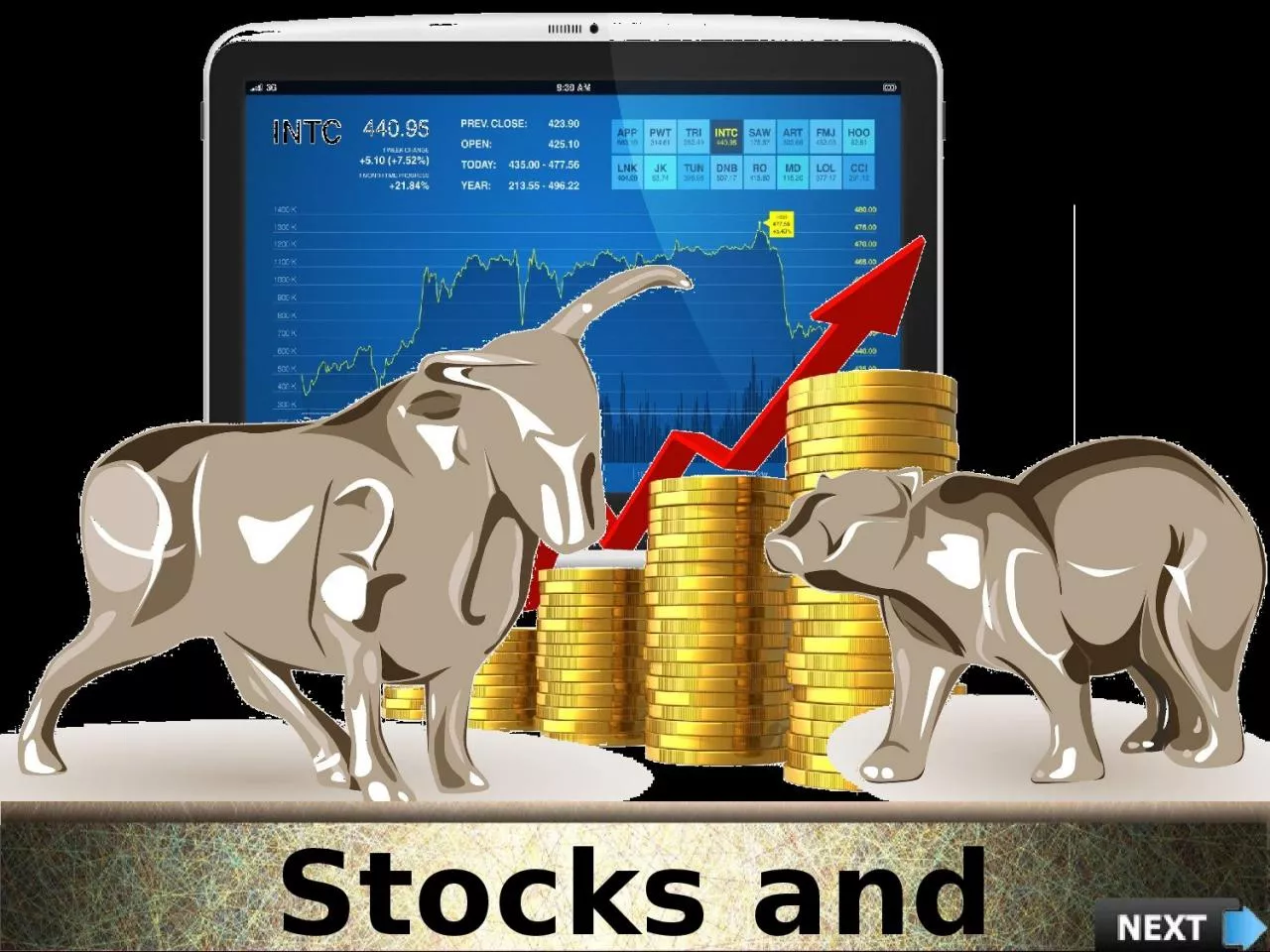

Explain What is a Stock Explain the Types of Stocks Explain the Classification of Common Stock Describe the Role of Beta in Your Portfolio List the Various Stock Screening Criteria Explain the Types of Analysis in Stock Trading ID: 1028988
Download Presentation The PPT/PDF document "Stocks and Investing Course Objectives" is the property of its rightful owner. Permission is granted to download and print the materials on this web site for personal, non-commercial use only, and to display it on your personal computer provided you do not modify the materials and that you retain all copyright notices contained in the materials. By downloading content from our website, you accept the terms of this agreement.
1. Stocks and Investing
2. Course ObjectivesExplain What is a StockExplain the Types of StocksExplain the Classification of Common StockDescribe the Role of Beta in Your PortfolioList the Various Stock Screening CriteriaExplain the Types of Analysis in Stock TradingExplain the Ratios for Valuing FirmsList the Criteria for Choosing a BrokerExplain the Common Stock Investing StrategiesExplain the Steps of a Typical Stock TransactionExplain How to Read Stock QuotationsExplain the Calculation of Price-to-Earnings Ratio (PE)Explain the Key Terms of Stocks and Investments Describe the Rights of a StockholderDescribe the Various Investment Options
3. IntroductionPeter Looney works as an executive. For a long time, Peter has felt that he should invest the extra amount of money that he makes from his job.
4. IntroductionHe has been saving in cash form for a long time.However, he wants that he should use the saved amount to invest in something that could help him multiply his money and help grow his finances.
5. IntroductionPeter has always thought of starting a business venture to grow his money, however, he is greatly averse to the huge amount of risk involved in any business venture.So, Peter starts asking advice from his colleagues about what possible investment options are available in the market.
6. IntroductionGeorge, one of Peter’s colleagues, advices him to invest in stocks and mutual funds.Stocks are the capital raised by a corporation through the issue of shares entitling holders to an ownership interest also known as ‘equity’.
7. What is a Stock? Any business needs money or capital whenever it has to start its operations or expand its business operations. Thus, in order to raise this capital for a business start-up or expansion, the corporation would offer shares of stock for sale to the public.
8. Cyclical StocksCyclical Stocks: ‘Cyclical Stock’ is stock exhibiting above-average sensitivity to the business cycle. These are issue by companies whose share prices move up and down with the state of the economy.Cyclical Stocks
9. Understanding Leverage1‘Leverage’ is another important concept while learning about stocks and investing. ‘Leverage’ is the process of increasing your purchasing power by borrowing money to invest in more assets.2Therefore, it is very natural that the ‘Leverage’ increases your risk as you invest more than your own financial capacity by borrowing from others.3Also, when you borrow money for investing the rate of return on the loan is fixed, however, there is no fixed or guaranteed rate of return on your investments.
10. Political or Regulatory RiskPolitical or Regulatory Risk:‘Political or Regulatory Risk’ is a risk that unanticipated changes in the tax or legal environment will have an adverse impact on a business.Political or Regulatory Risk
11. Stock Screening CriteriaIt is very important that you should screen each and every stock that you intend to buy or sell before deciding on a purchase or sale. Screening the stock carefully on certain crucial criteria will help you make informed and wise decision to safeguard your money against risk as well as losses.
12. Stock Indexes of the USYou can find out information about every stock and the important financial news for a given day from the financial indexes that are published in newspapers. Many leading daily newspapers and daily publications such as the Wall Street Journal, Investors Daily publish the latest stock trading information for the various exchanges.
13. Reading Stock Quotations HILOWSTOCSYMBOLDIVYLDPEVOL IN 100SHILOCLOSECHANGE12983IBMIBM$1.401.2%1917.9987114113113-152 WEEK CYCLEThe second column ‘LOW’ shows the 52-week lowestLet us now look at the table and try to read the stock quotation shown:value of the IBM stock as $83.00.
14. Reading Stock Quotations HILOWSTOCSYMBOLDIVYLDPEVOL IN 100SHILOCLOSECHANGE12983IBMIBM$1.401.2%1917.9987114113113-152 WEEK CYCLEThe ninth column ‘HI’ shows the previous day’s highestLet us now look at the table and try to read the stock quotation shown:value of the IBM stock as $114.00.
15. Classifications of BondsBonds can be classified into the following based on various criteria:Transfer MethodPriceMaturityConvertibilityCollateralCollateral: Bonds are classified based on the kind of collateral offered into the following two types:Secure Bond: ‘Secured Bond’ is a bond for which interest and principal payments are backed by assets or future cash flows pledged as collateral. Thus, a secured bond is fully secured by a specific asset that can be sold by the bondholder to satisfy a claim.Debenture: ‘Debentures’ are ‘unsecured bonds’ in the form of a certificate or voucher acknowledging a debt. Thus, a debenture or unsecured bond is secured only by the issuer's reputation and credit.
16. The BullsWhen you start investing in the stock market, two of the very popular terms that you would hear is the ‘Bulls’ and the ‘Bears’.The ‘Bulls’ is used to refer to an investor with an optimistic market outlook. Hence, a ‘bull’ is an investor who expects prices to rise and so buys now for resale later.Similarly, a ‘bull’ market is when everything in the economy is going great, people are finding jobs, Gross Domestic Product (GDP) is growing, and stocks are rising. So, a ‘bull’ market is one where stock prices are rising.
17. This is a DEMO Course On – Stocks and Investing.Register Today and Get Access to FREE Courses.What Do you Get:View All Courses Online.Download Powerpoint Presentation for Each Course.Do the Knowledge Checks for Each Course.ManagementStudyGuide.com